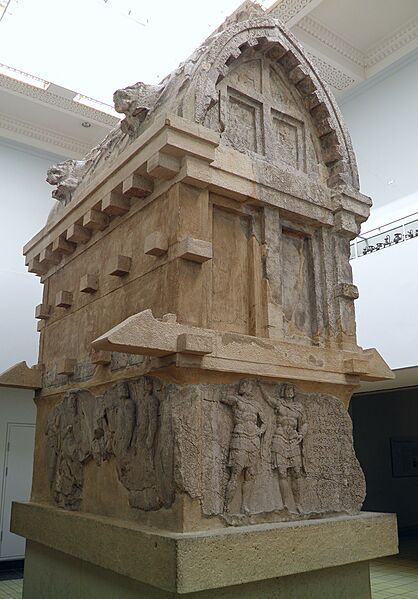Image: The tomb of Payava, a Lykian aristocrat, about 375-360 BC, from Xanthos, British Museum (9504934234)

Description: One of the most common forms of free-standing Lykian tombs is the barrel-vaulted sarcophagus, placed on a high base, with architectural features carved in stone to imitate wooden structures. The British Museum has one complete barrel-vaulted tomb from Lykia. The occupant, Payava, is named in an inscription. The figures carved on the walls of the tomb combine Greek and Persian elements. On one of the shorter sides an athlete seems entirely Greek, and his bearded companion is dressed in Greek style, but on the adjacent side a dignified seated figure in full Persian dress is shown receiving a delegation. This may be the satrap (local ruler) Autophradates, who is named in the inscription as having made a presentation to Payava. On the other long side of the tomb is a scene of a battle. The second short side has two long-haired and bearded men, wearing cuirasses and a cloak. The inscription on this side names Payava, who may be one of the soldiers represented. The heads and foreparts of lions, a favourite Lykian royal symbol, project from the curved roof. The roof is decorated with a chariot seemingly at full speed, a Greek motif enlivened by the fact that the horses turn their heads in different directions. The seated couple in the gable ends are again Persian, and correspond with a similar dynastic pair in one of the pediments of the Nereid Monument from Xanthos. In the pediments above these seated figures are pairs of sphinxes, traditional guardians of the dead. On the uppermost level are two friezes showing on one side a wild animal hunt, including a fierce bear raised up on its hind legs, and on the other a battle between cavalry and foot-soldiers. This sarcophagus was discovered at Xanthos by Sir Charles Fellows in 1838, and described as the 'Gothic-formed Horse Tomb'. M. Caygill, The British Museum A-Z compani (London, The British Museum Press, 1999) E. Slatter, Xanthus: travels and discovery (London, Rubicon Press, 1994) A.H. Smith, A catalogue of sculpture in -1, vol. 2 (London, British Museum, 1900) www.britishmuseum.org/explore/highlights/highlight_object...
Title: The tomb of Payava, a Lykian aristocrat, about 375-360 BC, from Xanthos, British Museum (9504934234)
Credit: The tomb of Payava, a Lykian aristocrat, about 375-360 BC, from Xanthos, British Museum Uploaded by Marcus Cyron
Author: Carole Raddato from FRANKFURT, Germany
Usage Terms: Creative Commons Attribution-Share Alike 2.0
License: CC BY-SA 2.0
License Link: https://creativecommons.org/licenses/by-sa/2.0
Attribution Required?: Yes
Image usage

